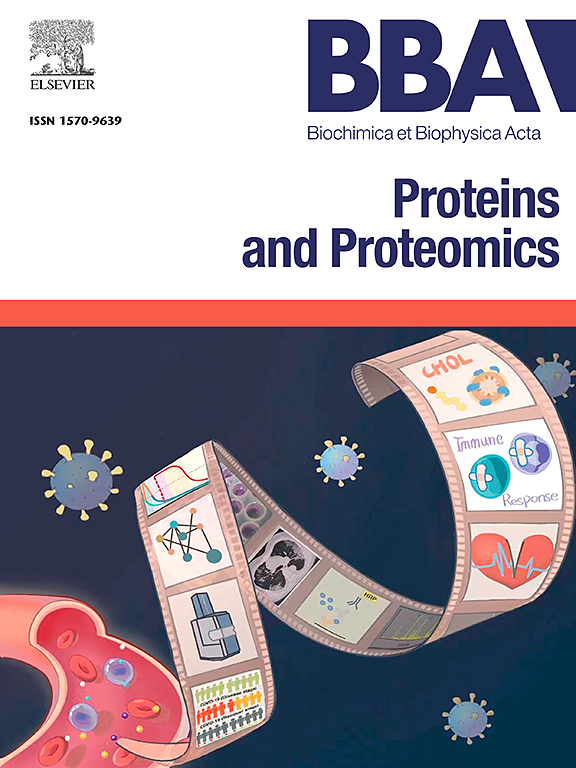Neuropilin-1的糖蛋白组学特征揭示了SARS-CoV-2进入的关键糖基化位点。
IF 2.3
4区 生物学
Q3 BIOCHEMISTRY & MOLECULAR BIOLOGY
Biochimica et biophysica acta. Proteins and proteomics
Pub Date : 2025-07-14
DOI:10.1016/j.bbapap.2025.141089
引用次数: 0
摘要
SARS-CoV-2刺突(S)糖蛋白与人类宿主受体(包括ACE2、NRP1和AXL)的结合对病毒进入至关重要。刺突蛋白及其宿主受体的糖基化可以显著影响这些相互作用。虽然NRP1被认为是一个关键的宿主受体,但其糖基化在刺突结合和病毒感染中的作用尚未完全阐明。在这项研究中,我们在HEK293细胞中使用重组蛋白开发了一种钉钉-NRP1结合实验,并进行了基于lc - ms的糖蛋白组学分析来表征NRP1的糖基化。我们在NRP1上鉴定了3个n -链糖基化位点(N150、N261、N522)和4个o -链糖基化位点(S612、S637、T638、S641)。突变分析显示,这些特定位点的糖基化对刺突结合至关重要,因为单位点突变体的相互作用明显减少。进一步表征末端唾液酸键、分割GlcNAc和聚焦模式,有助于深入了解NRP1糖基化的复杂性。功能分析表明,糖基化的缺失损害了SARS-CoV-2假病毒的进入,并改变了IL-6的分泌,表明在宿主免疫调节中发挥了更广泛的作用。这些发现表明,在基于细胞的模型中,位点特异性NRP1糖基化调节刺突结合和病毒进入,为未来研究探索SARS-CoV-2感染中靶向糖基化依赖机制的潜力奠定了基础。本文章由计算机程序翻译,如有差异,请以英文原文为准。
Glycoproteomic characterization of Neuropilin-1 reveals critical glycosylation sites for SARS-CoV-2 entry
The binding of the SARS-CoV-2 spike (S) glycoprotein to human host receptors, including ACE2, NRP1, and AXL, is essential for viral entry. Glycosylation of both the spike protein and its host receptors can significantly influence these interactions. While NRP1 is recognized as a key host receptor, the role of its glycosylation in spike binding and viral infectivity has not been fully elucidated. In this study, we developed a spike-NRP1 binding assay using recombinant proteins in HEK293 cells and performed LC-MS-based glycoproteomic analysis to characterize NRP1 glycosylation. We identified three N-linked glycosylation sites (N150, N261, N522) and four O-linked glycosylation sites (S612, S637, T638, S641) on NRP1. Mutational analysis revealed that glycosylation at these specific sites is critical for spike binding, as single-site mutants showed significantly reduced interaction. Further characterization of terminal sialic acid linkages, bisecting GlcNAc, and fucosylation patterns provided insight into the complexity of NRP1 glycosylation. Functional assays demonstrated that loss of glycosylation impaired SARS-CoV-2 pseudovirus entry and altered IL-6 secretion, indicating a broader role in host immune modulation. These findings demonstrate that site-specific NRP1 glycosylation modulates spike binding and viral entry in a cell-based model, providing a foundation for future studies to explore the potential of targeting glycosylation-dependent mechanisms in SARS-CoV-2 infection.
求助全文
通过发布文献求助,成功后即可免费获取论文全文。
去求助
来源期刊
CiteScore
8.00
自引率
0.00%
发文量
55
审稿时长
33 days
期刊介绍:
BBA Proteins and Proteomics covers protein structure conformation and dynamics; protein folding; protein-ligand interactions; enzyme mechanisms, models and kinetics; protein physical properties and spectroscopy; and proteomics and bioinformatics analyses of protein structure, protein function, or protein regulation.

 求助内容:
求助内容: 应助结果提醒方式:
应助结果提醒方式:


